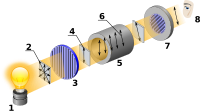Specific rotation

Okay, so imagine you have a toy car that spins around and around. When it's spinning, you can see it moving and turning all over the place. The same thing happens with light.
When light waves move through something, like liquid, they can get twisted and turned around. This is kind of like your toy car spinning – the light waves are moving and turning all over the place.
Now, scientists can measure how much the light waves are turning by using something called a polarimeter. They put the liquid in the polarimeter and shine light through it. Then they can see how much the light waves have turned.
The amount that the light waves have turned is called the specific rotation. It's like saying how many times your toy car spun around. But instead of counting the spins, scientists use a special unit called degrees.
So, specific rotation is a way to measure how much light waves get twisted and turned when they move through certain liquids. Scientists use this measurement to help them learn more about different substances and how they work.
When light waves move through something, like liquid, they can get twisted and turned around. This is kind of like your toy car spinning – the light waves are moving and turning all over the place.
Now, scientists can measure how much the light waves are turning by using something called a polarimeter. They put the liquid in the polarimeter and shine light through it. Then they can see how much the light waves have turned.
The amount that the light waves have turned is called the specific rotation. It's like saying how many times your toy car spun around. But instead of counting the spins, scientists use a special unit called degrees.
So, specific rotation is a way to measure how much light waves get twisted and turned when they move through certain liquids. Scientists use this measurement to help them learn more about different substances and how they work.
